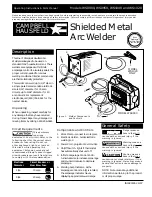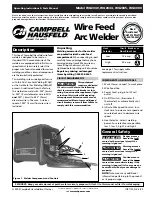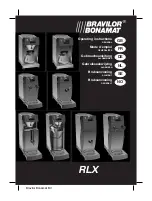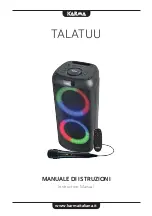
57
Removing the slag
Welding using covered electrodes requires the removal of the
slag after each run.
The slag is removed by a small hammer or is brushed away if
friable.
7.2 TIG welding (continuos arc)
The TIG (Tungsten lnert Gas) welding process is based on the
presence of an electric arc struck between a non-consumable
electrode (pure or alloyed tungsten with an approximate melt-
ing temperature of 3370°C) and the work-piece; an inert gas
(argon) atmosphere protects the weld pool.
To avoid dangerous inclusions of tungsten in the joint, the elec-
trode must never come in contact with the workpiece; for this
reason the welding power source is usually equipped with an
arc striking device that generates a high frequency, high voltage
discharge between the tip of the electrode and the workpiece.
Thus, thanks to the electric spark, ionizing the gas atmosphere,
the welding arc is struck without any contact between electrode
and workpiece.
Another type of start is also possible, with reduced tungsten
inclusions: the lift start, which does not require high frequency,
but only an initial short-circuit at low current between the elec-
trode and the workpiece; when the electrode is lifted, the arc
is established and the current increases until reaching the set
welding value.
To improve the quality of the filling at the end of the welding
bead it is important to control carefully the down slope of the
current and it is necessary that the gas still flows in the welding
pool for some seconds after the arc is extinguished.
Under many operating conditions, it is useful to be able to use
two preset welding currents and to be able to switch easily from
one to the other (BILEVEL).
Welding polarity
D.C.S.P. (Direct Current Straight Polarity)
This is the most used polarity and ensures limited wear of the
electrode (1), since 70% of the heat is concentrated in the
anode (piece).
Narrow and deep weld pools are obtained, with high travel
speeds and low heat supply.
Most materials, except for aluminium (and its alloys) and mag-
nesium, are welded with this polarity.
D.C.R.P. (Direct Current Reverse Polarity)
The reverse polarity is used for welding alloys covered with a
layer of refractory oxide with higher melting temperature com-
pared with metals.
High currents cannot be used, since they would cause excessive
wear on the electrode.
D.C.S.P.-Pulsed (Direct Current Straight Polarity Pulsed)
The use of pulsed direct current allows better control, in particu-
lar operating conditions, of the welding pool width and depth.
The welding pool is formed by the peak pulses (Ip), while the
basic current (Ib) keeps the arc ignited.
This operating mode helps to weld thinner metal sheets with
less deformations, a better form factor and consequently a lower
danger of hot cracks and gas penetration.
Increasing the frequency (MF) the arc becomes narrower, more
concentrated, more stable and the quality of welding on thin
sheets is further increased.
7.2.1 Steel TIG welding
The TIG procedure is very effective for welding both carbon and
alloyed steel, for first runs on pipes and for welding where good
appearance is important.
Straight polarity is required (D.C.S.P.).
Preparing the edges
Careful cleaning and preparation of the edges are required.
Choosing and preparing the electrode
You are advised to use thorium tungsten electrodes (2% thorium-
red coloured) or alternatively cerium or lanthanum electrodes
with the following diameters:
Ø electrode (mm)
current range (A)
1.0
15÷75
1.6
60÷150
2.4
130÷240
The electrode must be sharpened as shown in the figure.
(°)
current range (A)
30
0÷30
60÷90
30÷120
90÷120
120÷250
Filler metal
The filler rods must have mechanical characteristics comparable
to those of the parent metal.
Do not use strips obtained from the parent metal, since they
may contain working impurities that can negatively affect the
quality of the welds.
Shielding gas
Tipically, pure argon (99.99%) is used.
Welding
current (A)
6-70
60-140
120-240
Ø Electrode
(mm)
1.0
1.6
2.4
Gas nozzle
n° Ø (mm
)
4/5 6/8.0
4/5/6 6.5/8.0/9.5
6/7 9.5/11.0
Argon flow
(l/min)
5-6
6-7
7-8
Содержание Genesis 3200 GSM
Страница 32: ...32...
Страница 90: ...90...
Страница 120: ...120...
Страница 150: ...150...
Страница 180: ...180...
Страница 210: ...210...
Страница 325: ...1 1 1 10 C 40 C 14 F 104 F 25 C 55 C 13 F 131 F 50 40 C 40 00 C 90 20 C 68 F 2000 6500 1 2 10 MIG MAG 325...
Страница 326: ...326 1 3 1 4 11 35 1 5 1 6...
Страница 327: ...327 8 1 7 EN IEC 60974 10 B A A EN60974 10 A pace maker Zmax Ssc Point of Commom Coupling PCC...
Страница 328: ...1 8 IP S IP23S 12 5 mm 60 2 2 1 2 2 10 2 3 400V 230V 15 15 2 1 5 328...
Страница 329: ...329 2 4 MMA 3 4 1 2 WF TIG 4 3 TIG 5 6 7 8 9 10 MIG MAG CAN BUS RC 11 12 13 o 14 15 16 17 A4 MIG 18 19 20 21...
Страница 344: ...5 6 Reset 344...
Страница 345: ...345 encoder...
Страница 346: ...346...
Страница 347: ...347 7 7 1 MMA Hot Start Arc Force antisticking 7 2 TIG TIG Tungsten lnert Gas 3370 C H F lift...
Страница 349: ...349 7 2 2 TIG TIG TIG TIG 7 3 MIG MAG MIG SHORT ARC 1a SHORT a SPRAY ARC b SPRAY ARC 1b 2 3 2 3 1a 1b...
Страница 352: ...352...
Страница 355: ...355 11 Schema Diagram Schaltplan Sch ma Esquema Diagrama Schema kopplingsschema Oversigt Skjema Kytkent kaavio...
Страница 357: ...357...
Страница 360: ...360...
















































